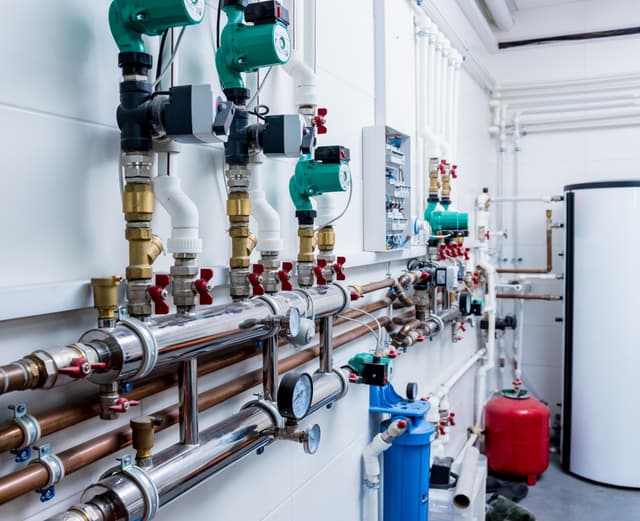Plumbing Systems in Multi-Unit Residential Buildings

1. Introduction
In modern multi-family plumbing systems, especially in apartment plumbing and condos, a reliable and efficient design is essential. Unlike single homes, any failure like a clogged drain, burst pipe, or failing water heater installation can impact multiple residents. Issues often demand a quick emergency plumber response.
As a licensed plumber or building manager, understanding the core structure of residential plumbing and the most frequent pain points like poor water pressure, failing backflow prevention, and ineffective leak detection can dramatically reduce costs and complaints.
2. Key System Components & Design Considerations
a) Water Supply & Pressure Control
Maintaining consistent water pressure across multiple units is critical. Pressure regulating valves and booster systems prevent overpressurization or lack of flow to upper floors. Improperly regulated pressure often results in pipe repair costs or mold issues from slow leaks.
b) Hot Water Delivery
Tankless water heater systems and centralized boilers are common. Each has pros and cons regarding maintenance, installation cost, and hot water recovery rate. High-efficiency water heater installation remains a major search trend, especially for energy-saving solutions.
c) Drainage & Venting
Proper drainage layout ensures fast discharge without airlocks or clogs. Vent stacks are crucial for air balance, preventing sewer gas from entering units. A blocked vent line can act just like a clogged drain.
d) Pipe Materials: CPVC vs. PEX vs. Copper
- CPVC: Long life, chlorine-resistant, great for large vertical risers.
- PEX: Easy to install, lower cost, but not ideal with high-oxidant municipal water.
- Copper: Best longevity, high cost, prone to corrosion in acidic water.
e) Maintenance Access & Traps
Ensure plumbing inspection points are easily accessible. Properly located cleanouts, backwater valves, and drain traps can minimize the time needed for diagnostics or drain cleaning.
f) Safety & Cross-Connection Control
In any multi-unit setup, backflow prevention devices are essential to protect potable water from contamination. Missing or broken valves can trigger health violations or code infractions.
3. Common Failures & Repair Strategies
a) Leak Detection
Failure to address small leaks early can cause massive repair costs. Use technology: infrared cameras, acoustic sensors, and flow meters. Many 24-hour plumber services offer these checks as a premium feature.
b) Clogs & Drain Backups
Drain cleaning and hydro jetting are essential tools when standard snakes can’t remove grease or debris. In food-heavy buildings (with many units doing cooking), kitchen plumbing is a frequent clog source.
c) Toilet & Fixture Failures
Outdated or poorly maintained fixtures can trigger complaints or flooding. Consider periodic toilet installation upgrades, especially in older units. Look for low-flow, dual-flush options.
d) Pressure Damage & Water Hammer
Install hammer arrestors and maintain proper regulator settings. Sudden pressure changes damage valves and joints, requiring urgent pipe repair.
4. Trends & Best Practices in Multi-Unit Plumbing
a) Smart Monitoring
Install building-wide leak monitors and Wi-Fi pressure sensors. Predictive maintenance is a growing trend.
b) Recirculation Efficiency
To avoid long wait times for hot water, looped systems with timers or sensors reduce waste while improving comfort.
c) Sustainable Plumbing Materials
Eco-friendly materials are growing. CPVC and PEX emit less CO2 in production compared to copper. Some builders are pushing for fully recyclable plumbing kits.
d) Centralized Mechanical Systems
Central boiler rooms simplify repair access and improve system efficiency. Skilled plumbing contractors favor modular designs for ease of maintenance.
5. Preventive Maintenance & Service Contracts
Having a service contract with a plumbing contractor offers the following:
- Scheduled plumbing inspection
- Priority emergency plumber access
- Regular sump pump repair, backflow tests, and drain cleaning
- Coverage for kitchen plumbing, fixture replacements, and more
These contracts also optimize SEO content by targeting terms like "repair plumbing near me" or "licensed plumber Toronto."
6. Final Thoughts
Multi-unit residential plumbing is both a science and an art. From smart design to preventive care, building owners must stay ahead of failures using expert plumbers, modern materials, and well-documented service logs. Whether installing a toilet, planning a new water heater installation, or simply clearing a clogged drain, having a qualified plumbing contractor on call is non-negotiable.
📌 Research Sources
- PM Magazine – Trends in Multi-Family Plumbing
- FlowGuard Gold – CPVC in Multi-Unit Systems
- ResearchGate – Plumbing Defect Reports






